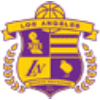When a player is chosen with the second overall pick in the NBA Draft, among all college and international players around the world, it comes with high expectations. It is assumed that such players will start immediately, compete for NBA Rookie of the Year honors, and after the All-Star break play at a very high level. This was particularly true for Brandon Ingram of the Los Angeles Lakers because many scouts labeled him the best player in the draft although he was eventually chosen second.
However, the reality does not always mesh with the expectations. Just ask D’Angelo Russell, selected No. 2 in the 2015 draft by the Lakers. From the moment he began to play in Summer League to the day his rookie season ended, Russell struggled on and off the court. He had a good game here and there but could never gain any consistency. He suffered the indignity of not making the All-Rookie team and barely cracked the top 10 in rookie rankings at the end of the season.
For the second year in a row, the Lakers nabbed the No. 2 overall pick in the draft. After Russell’s struggles, fans were hoping for someone who was more NBA-ready than Russell was, someone who could make a name for himself in his first season like Karl-Anthony Towns, Kristaps Porzingis, and Devin Booker did last year.

The hyperbole machine began right away. Ingram was immediately proclaimed to be the next Kevin Durant. The Lakers need improvement in all categories but none more than consistent outside shooting. If Ingram could come even close to the scoring prowess of Durant, it would be a huge boost for the purple and gold.
Last year, Russell played 19 minutes per preseason game and averaged 8.8 points per contest. He shot 43 percent from the field and connected on 70 percent of his free throws. He only attempted two three-point shots and made one of them. He also averaged three rebounds and two assists per game. His performance was labeled a disappointment.
But Russell’s statistics were positively Michael Jordan-like compared to Ingram’s statistics through half of this year’s preseason. He is playing more minutes than Russell played (21 minutes a night) but averaging only four points on 28.6 percent shooting from the floor and 23.1 percent from three-point range. He has made only 35.7 percent of his free throws which makes Dwight Howard and DeAndre Jordan seem proficient from the line. He is also averaging two rebounds and less than one assist per game. There is no way to sugar-coat those statistics.

It is an understatement to say that through five games Ingram has shot poorly. He has only made a couple of outside shots, and one of his makes was a shot he missed so badly that it luckily banked in. Another time he was tied up driving to the basket, and it should have been a jump ball, but the referee didn’t make the call, and at the last second, with both players wrestling for the ball, it squirted up in the air and banked in. Otherwise, he has made a couple of ally-oop shots at the rim, and that is about it. His attempts to drive to the rim have repeatedly been blocked, and from the outside, he has clanked one shot after another.
Ingram is a rookie, and perhaps it was unfair to expect his game to take off right away. But that is not a complete excuse. The Lakers played two games recently against the Denver Nuggets, who prominently featured three rookies all of whom are far less heralded than Ingram. Malik Beasley, Juancho Hernangomez, and Jamal Murray were chosen well below Ingram in the first round, but all looked far more polished and NBA ready than Ingram.
Between Summer League and five preseason games, there is a decent sample size, and it is pretty apparent that Ingram is not the immediate savior they thought the Lakers might be getting when he was drafted.

Despite his very slow start, there are positives. For one thing, he makes a big effort to play defense and does well – his enormous wingspan disrupts shots whenever he raises his arms. For another, Ingram has a great attitude. He does not act like an entitled prima donna. He is coachable and is willing to do anything to contribute, and he does not get overly discouraged. Whatever he may feel on the inside, Ingram does not seem shaken by the slow start.
Ingram is going to improve slowly as his very slender body matures, and he will get better and better. He may not be the immediate superstar the fans thought the team had drafted, but his upside is still very good. As with Russell, it is going to be a work in progress and will take time.
Ingram is going to be fine, and probably better than fine, but for the second year in a row the Lakers used a very high draft choice on something of a project, a 19-year-old with high upside potential instead of someone who could make a big impression in his first year like Towns, Porzingis, and Booker did last season. The evidence so far does not suggest that Ingram will be competing for NBA Rookie of the Year honors, even with Ben Simmons out, but he is a great guy who people will root for and eventually he’ll come around.
At the end of the day, while the Lakers have several good young role players who are improving, ownership has invested most of its poker chips on Ingram and Russell for the future. The team cannot afford to strike out on those two top draft choices in an era where convincing prominent free agents to come to a losing team is nearly impossible. Ingram and Russell must reach, or at least approach, All-Star status in the next three years or the team will remain out of the playoff picture indefinitely.




